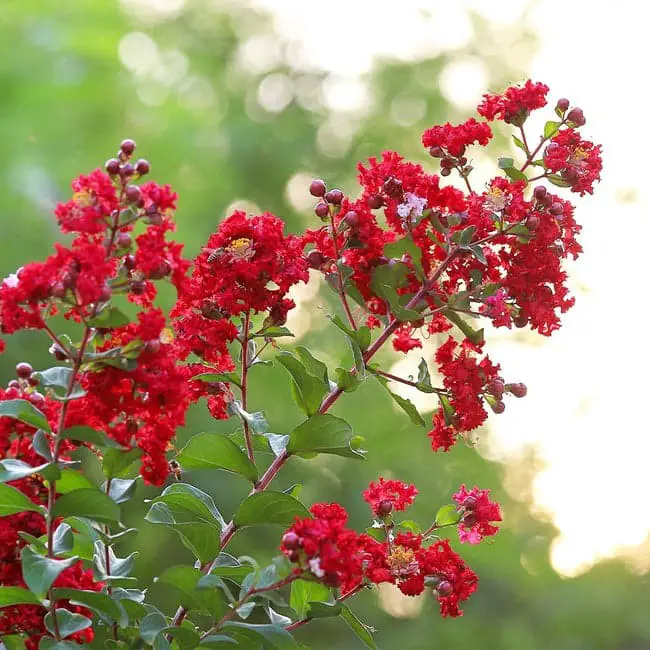23 Magnificent Trees With Stunning Red Flowers (Names And Pictures)
When most people think about trees, they often focus on their leaves or branches. However, some trees have stunning floral displays that can add a pop of color to any landscape. One example is the magnolia tree, which boasts beautiful red flowers that can turn any garden into a masterpiece. But there are many more trees out there with striking red blooms.
Some examples include the African Tulip Tree, Bottlebrush, Calliandra, Colorama Scarlet Crape Myrtle Tree, Crabapple Tree, Dynamite Crape Myrtle, Flame of the Forest, Indian Coral Tree, Japanese Flowering Quince, Oleander, Pomegranate Tree, Red Dogwood, Red Flowering Gum, Red Frangipani, Red Rocket Crape Myrtle, Red Rose of Sharon Althea Tree, Red Silk Cotton Tree, and many others.
With such a wide range of options, there’s sure to be a red flowering tree that suits any garden or landscape design. Keep reading to learn more about these magnificent trees and their stunning red flowers!
Red flowering tree identification.
While it’s true that there are numerous types of red flowering trees, several key characteristics can aid in identification, especially for those unfamiliar with them. One crucial factor is the shape and size of the tree itself. For instance, a tall and slender tree is likely to be a Redwood, whereas a shorter and bushier one might be a Maple or Oak. Another decisive characteristic is the appearance of the flowers.
This often proves to be the most straightforward method for identifying a red flowering tree. Take note of their size, shape, and color – are they small and delicate, or large and showy? Lastly, examine the leaves. Although typically green, those of a red flowering tree can also be yellow, orange, or even take on a reddish hue. This can prove a valuable clue when struggling to pinpoint the tree’s species.
23 Red Flowering Trees With Pictures
African Tulip Tree (Spathodea campanulata).

The African tulip tree stands out with its remarkable height of 50 feet (15 meters), its wide-spreading canopy and dark green, glossy leaves that cover its robust branches. Its vibrant floral display is just as impressive, featuring large, brightly colored blooms ranging from orange to red hues. Native to Africa, this versatile tree has been introduced to other regions, including the Caribbean and Hawaii, where it thrives.
Interestingly, the African tulip tree plays a crucial role in many African cultures, serving as a vital source of wood for construction, furniture-making, and intricate carvings due to its hard and durable properties. As an ornamental plant, it is also prized for its stunning flowers, making it a popular choice among gardeners and nature enthusiasts alike.
Bottlebrush (Callistemon spp.).
Bottlebrushes, native to Australia and part of the Myrtaceae family, have gained popularity worldwide for their vibrant red blooms that burst forth in spring and early summer. These versatile plants can grow as small shrubs or mature into large trees, depending on the species. A key characteristic is their dense foliage, comprising slender leaves, which contrasts with their sharp, spiny branches.
The crown jewel of the bottlebrush plant, however, lies in its flowers – clusters of densely packed blooms that adorn the ends of the stems, featuring dozens of long, thin stamens that give rise to their distinctive brush-like appearance.
Calliandra.
Native to tropical and subtropical regions, the Calliandra genus is characterized by its stunning flowers, which range from white to pink to red hues. These showy blooms are borne in clusters, followed by seed pods containing numerous small seeds. The scientific name Calliandra originates from Greek words meaning ‘beautiful’ and ‘stamen’, referencing the prominent male reproductive organs of the flower.
As an ornamental plant, Calliandra is widely used for landscaping and street trees, as well as being a popular choice for bonsai enthusiasts. Its ease of care makes it adaptable to various soil types. While preferring full sun, the powder-puff tree tolerates partial shade. Notably, it is drought-tolerant and requires minimal watering once established.
Colorama™ Scarlet Crape Myrtle Tree (Lagerstroemia x ‘JM1’ PPAF).

Introducing Colorama Scarlet, the latest release from J. Frank Schmidt & Son Co. This stunning Crape Myrtle is a cross between ‘Natchez’ and ‘Ruby’, boasting large, deep red flowers that bloom from mid-summer to fall. The vibrant blooms are held aloft by sturdy stems that require no support, making them perfect for adding season-long interest to your landscape.
At 15-20 feet tall and 12-15 feet wide, Colorama Scarlet is a compact grower that thrives in full sun, where it can reach its full potential. Once established, this Crape Myrtle is heat and drought tolerant, ensuring it remains a beautiful and low-maintenance addition to your outdoor space.
Crabapple Tree (Malus sylvestris).
The majestic crabapple tree boasts a rich red hue, drawing parallels with its rose family origins, spanning native habitats across Europe, Asia, and North America. At heights ranging from 20-30 feet, this deciduous tree thrives for approximately three decades to five decades, yielding leaves with an oval shape and toothed edges. Springtime brings forth an explosion of flowers, expertly pollinated by busy bees.
The small, tart apples produced by the crabapple tree come in a palette of red, green, or yellow – each bite offering a tangy and acidic taste experience. As a food source for both humans and animals, this versatile tree plays an essential role.
The sturdy wood, renowned for its hardness and strength, finds applications in furniture crafting, flooring installation, and wall construction.
Beyond its practical uses, the crabapple tree holds symbolic significance across various cultures – in China, it symbolizes good fortune; in the United States, it proudly serves as Missouri’s state tree.
Dynamite Crape Myrtle (Lagerstroemia indica ‘Whit II’).

This vibrant deciduous shrub or small tree is a stunning addition to any garden. From late spring to early fall, it produces an abundance of bright red flowers that attract butterflies and hummingbirds. The Dynamite Crape Myrtle thrives in full sun and well-drained soil, making it a low-maintenance option for even the most novice gardener. Once established, it’s also surprisingly drought-tolerant. To maintain its desired shape, simply prune it in late winter to early spring.
With its ability to add color and interest to your landscape for several months of the year, this Crape Myrtle is a great choice for gardeners of all levels.
Flame of the Forest (Butea monosperma).

In the Indian states of Uttarakhand and beyond, a majestic sight can be seen during the spring months of April and May – the Palasha tree, also known as Flame of the Forest, in full bloom. Its vibrant flowers are not only a treat for the eyes but also hold practical value, used to create natural dyes.
This resilient tree thrives under challenging conditions, tolerating both droughts and floods, and can grow up to 30 meters tall, its simple leaves arranged in pairs like sentinels on its sturdy branches. The flowers themselves are a kaleidoscope of colors – red, orange, and yellow – each with five delicate petals. As the seasons change, the tree produces small brown fruit, resembling tiny beans, adding to its natural charm.
Native to India, Pakistan, Nepal, Sri Lanka, and Bangladesh, the Flame of the Forest tree is often found in dry deciduous forests, claiming hill slopes and ravines as its own.
Indian Coral Tree (Erythrina Variegata).
The Indian Coral Tree, with its vibrant red blooms, is a stunning sight to behold. Native to the tropical regions of India, Sri Lanka, and Pakistan, this fast-growing tree can reach heights of up to 20 meters and spread out to 15 meters in diameter. Its pinnate leaves are comprised of small leaflets, while its showy flowers are borne on racemes at the leaf axils, featuring three petals and three sepals each. The fruit, a blackish-brown pod, splits open to release its seeds.
This versatile tree is not only a popular street tree in tropical regions but also an excellent choice for parks and gardens due to its shade-providing capabilities. Additionally, it can be used as a living fence or hedge, making it a valuable addition to any landscape.
Japanese Flowering Quince (Chaenomeles japonica).

This stunning deciduous tree boasts vibrant red flowers that bloom profusely in early spring, covering its branches in a kaleidoscope of color. The leaves are a lush green hue, while the edible fruit adds an extra layer of appeal. Reaching heights of around 15 feet, this tree thrives in full sun and is particularly well-suited for zones five through eight, where it can tolerate the local climate.
Native to Japan and China, its popularity in gardens and parks stems from its ease of growth and maintenance. Introduced to the United States in 1804, this charming tree has since become a sought-after addition to many landscaping projects. With minimal watering and fertilization requirements, pruning is merely necessary to maintain its attractive shape. Its versatility also makes it an excellent choice for creating hedges or screens, providing a natural yet stylish barrier.
Oleander (Nerium oleander).
Oleander, a shrub or small tree belonging to the dogbane family Apocynaceae, is often classified as the sole representative of the genus Nerium. Its common names, nerium and oleander, derive from its superficial resemblance to the unrelated olive Olea. This highly adaptable plant is native to the Mediterranean Basin, eastern Africa, and southern Asia, where it has thrived in diverse environments.
While oleander is widely cultivated, its ability to spread beyond its natural range has led to concerns about its invasive potential. In certain regions, it can be considered a weed due to its unchecked proliferation.
Growth-wise, oleander typically reaches a height of around 15 feet (occasionally stretching up to 23 feet). The flowers, which bloom in clusters at the end of each branch, are characterized by their white, pink or red hue and funnel-shaped corolla with a five-lobed mouth.
A few varieties exhibit yellow flowers or variegated leaves, while the fruit is a long, slender dehiscent capsule containing numerous seeds.
Unfortunately, oleander’s beauty belies its deadly toxicity. All parts of the plant are poisonous, and ingesting even small amounts can be fatal to humans and animals. This includes honey produced from the nectar, which can cause death upon consumption.
As one of the most toxic commonly grown garden plants, oleander has been implicated in numerous fatalities resulting from eating its leaves.
Toxic compounds responsible for this lethality include oleandrin and neriine, two saponins present throughout the plant. These agents are thought to be the primary causes of poisoning.
Pomegranate Tree (Punica granatum).
The vibrant pomegranate flowers boast five petals and a striking red hue. Meanwhile, the fruit itself takes the form of a juicy, round berry featuring a hard seed at its core. This ancient tree has its roots in the Mediterranean region, where it’s been cultivated for centuries. The California chapter of pomegranate history began when Spanish missionaries introduced the species to the state in the 18th century.
Red Dogwood (Cornus florida ‘Comco No. 1’).

The striking features of this tree are its vibrant red flowers, which boast a rich burgundy hue that contrasts stunningly with the lush green foliage. Native to the southeastern United States, it’s a common sight in many gardens within this region, and its popularity stems from its showy blooms and low-maintenance requirements. A popular choice for landscaping enthusiasts, its beauty and ease of care make it an attractive addition to any outdoor space.
Red Flowering Gum (Corymbia ficifolia).
A standout among the flowering gums, Red Flowering Gum boasts vibrant red blooms that make it an excellent choice for a street or garden tree. This evergreen tree can grow up to 15 metres in height and is known as Corymbia ficifolia. Its origins are rooted in Western Australia, where it thrives with a spreading crown of dense, glossy green leaves and smooth bark that sheds in thin strips.
In late spring and early summer, the Red Flowering Gum’s crowning glory becomes apparent – its large red flowers burst forth in profusion, followed by woody fruits containing numerous small seeds. With its striking appearance and modest size, this tree is sure to captivate and delight.
Red Frangipani (Plumeria rubra).
Native to Mexico, Central America, and the Caribbean, the Red Frangipani is a sought-after tree in tropical climates, prized for its ornamental value. Reaching heights of up to 20 feet, this striking specimen boasts large, dark green leaves that provide a lush backdrop for its showstopping blooms. The vibrant red flowers are not only a feast for the eyes but also emit a powerful fragrance, making them a true delight.
Red Rocket Crape Myrtle (Lagerstroemia indica ‘Red Rocket’).

Native to China and Korea, Red Rocket Crape Myrtle is a deciduous shrub or small tree that can grow up to 40 feet tall in ideal conditions. With its rounded habit, this cultivar boasts dark green foliage that transitions to a rich burgundy hue during the fall season. In late spring to early summer, it produces impressive panicles of deep red flowers that are sure to draw attention. Following the blooms, small brown seed capsules ripen in the fall and often linger into winter.
As a fast-growing plant, Red Rocket Crape Myrtle is relatively drought tolerant once established. Preferring full sun, but tolerating some shade, this crape myrtle makes an excellent choice for specimen planting, offering a striking visual display.
Red Rose of Sharon Althea Tree (Hibiscus syriacus).

The Red Rose of Sharon stands out as a deciduous shrub that can reach impressive heights of up to 12 feet. Its vibrant flowers, ranging from pure white to soft pink and deep red hues, are truly showstopping. This stunning rose variety blooms from June to September, making it a top pick for gardens and landscaping enthusiasts alike.
If you’re interested in learning more about the world of roses, we’ve got just the thing: our guide on Types Of Roses: How to Identify Different Roses (With Names & Pictures)
Red Silk Cotton Tree (Bombax ceiba).

The Red Silk Cotton Tree (Bombax species) is a native Indian subcontinent dweller, also found in Sri Lanka, Pakistan, and Bangladesh. Reaching heights of 30-40 meters (98-131 feet), this tree boasts a dense, rounded crown with long pendulous branches, showcasing its majestic presence.
Its leaves are quite distinctive, measuring large and simple, with five to seven deeply lobed sections that resemble palm fronds.
The flowers, a vibrant scarlet red, burst forth in clusters at the end of branches from February to April, painting the landscape with vibrant hues.
The fruit itself is a woody capsule filled with numerous small seeds, serving as a vital component of its life cycle.
In Hindu mythology, this tree holds sacred status and is often linked to the revered god Shiva. Furthermore, it serves as Dominica’s national tree, solidifying its cultural significance.
Red Silky Oak (Alloxylon flammeum).
In the heart of Australia, a majestic flowering tree thrives, boasting stunning features that captivate the senses. Its leaves are an extraordinary sight, with their large size and deeply lobed shape creating a silky texture that’s as smooth as silk. As the seasons change, the tree awakens in spring, showering the surroundings with vibrant red flowers that burst forth in profusion.
Reaching impressive heights, this majestic specimen adds a touch of elegance to any garden, making it an envy-worthy addition to any outdoor space.
Rhododendron (Rhododendron arboreum).
Native to the Himalayan regions of Nepal, Bhutan, and India, the stunning red flowering tree known as Rhododendron arboreum is a sight to behold. Its vibrant blooms emerge in May and June, painting the landscape with a kaleidoscope of colors. Reaching heights of up to 30 feet, this ornamental gem is often incorporated into gardens and landscaping projects for its unique beauty and striking floral displays.
Royal Poinciana Tree (Delonix regia).
The majestic Royal Poinciana tree, also affectionately referred to as the Flame Tree, is renowned for its vibrant red blooms that turn heads with their stunning beauty. Native to Madagascar, this tropical treasure has adapted to thrive in warm climates worldwide, earning a special place in the hearts of those who have had the pleasure of witnessing its splendor firsthand.
Scarlet Rosemallow Hibiscus (Hibiscus Coccineus).
The Scarlet Rosemallow Hibiscus is a vibrant addition to any garden, boasting showy scarlet flowers that attract bees and butterflies. As a native of the southeastern United States, it’s hardy in zones six through nine, making it an ideal choice for many regions. This deciduous hibiscus can be grown as a shrub or small tree, reaching heights of six to eight feet.
It thrives in full sun but will tolerate some light shade, and its well-drained soil requirements make it adaptable to most soil types. With its striking color and versatility, the Scarlet Rosemallow Hibiscus is a great option for gardeners seeking to add a pop of color to their outdoor spaces.
Shoeblackplant (Hibiscus rosa-sinensis).
In the 17th century, the Hibiscus rose-sinusianus, commonly referred to as the shoeblackplant, was introduced to Europe from its native China. Since then, it has become a staple in many ornamental gardens due to its striking features and ease of care. This versatile plant can thrive as both a shrub and a small tree, with its large, vibrant flowers coming in shades of red, pink, or white.
One of the shoeblackplant’s greatest assets is its low-maintenance nature, making it an excellent choice for gardeners of all skill levels.
Witch Hazel (Hamamelis x intermedia ‘Diane’).
Diane, a compact shrub, boasts slender and upright branches adorned with lustrous, dark green leaves. As the seasons transition into autumn, the foliage transitions to a vibrant golden yellow before shedding its final leaves. However, it’s during the winter months (December to February) that this shrub truly comes alive. During this time, Diane is blanketed in striking red flowers that seem to radiate against the serene winter backdrop, creating a breathtaking visual display.
FAQs
What kind of tree has small red flowers?
Flowering dogwood trees, also known as Cornus florida, are a stunning addition to any landscape. These native North American trees thrive in a variety of conditions and can grow up to 25 feet tall. The tree’s claim to fame is its vibrant, red flowers that bloom in the spring, drawing attention to their small but striking size. As popular ornamental trees, flowering dogwoods are frequently planted in gardens and parks, where they provide shade, beauty, and a touch of natural charm.
What trees bloom red in spring?
Among the first signs of spring’s arrival are the vibrant red blooms of several tree species. The Red Maple, Scarlet Oak, and Redbud trees each boast distinct characteristics that set them apart in the awakening landscape. The Red Maple, a ubiquitous presence in North America, is one of the earliest to burst forth with color, its beauty on full display for all to enjoy.
Meanwhile, the Scarlet Oak, native to the eastern United States, earns its name from the deep crimson hue of its leaves as they unfurl in spring’s warmth. In contrast, the diminutive Redbud, a southern native, showcases stunning bright pink flowers that add a pop of color to the season’s early days.
What trees bloom red in summer?
While many people associate red flowers with springtime, there are indeed some stunning summer bloomers to be found – and they’re mostly deciduous trees! The most well-known of these is the majestic Red Maple, its vibrant hue a true showstopper in mid-summer. Other notable mentions include the Scarlet Oak, Bloodgood London Planetree, and Crimson King Maple, all sharing this unique characteristic.
It’s worth noting that summer-blooming red trees typically shed their leaves during winter, making them deciduous. On the rare occasion an evergreen does produce red blooms – like the Southern Magnolia – these are few and far between.
Conclusion
Trees with red flowers are undoubtedly among the most stunning and awe-inspiring in the world. Their breathtaking beauty is a treat that should not be missed by anyone who has the chance to witness it firsthand. These magnificent trees bring vibrancy and vitality to any landscape, leaving a lasting impression on all who have the pleasure of beholding them.
Related Posts
Discovering the wonders of online plant nurseries is not limited to just one type of tree. From majestic evergreens to vibrant apple trees, these digital destinations offer a vast array of flora for enthusiasts and professionals alike. For those looking to turn their passion into a career, becoming an arborist requires dedication and knowledge in tree care. This pursuit has far-reaching impacts on properties, from boosting curb appeal to enhancing overall aesthetic.
On the flip side, strategically removing trees can also elevate a home’s charm. But that’s not all – did you know that growing your own organic blueberry plants is possible? With the right tips and care, these sweet treats can thrive in your very own garden.






